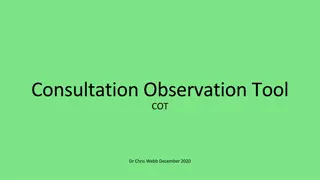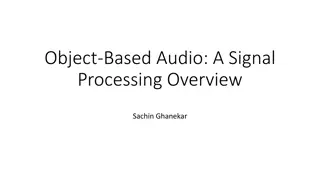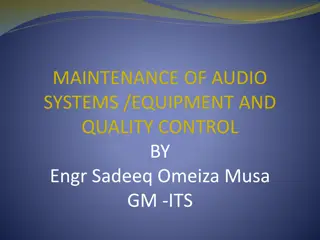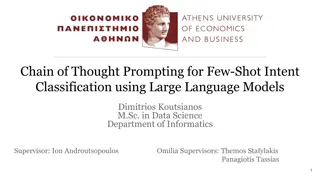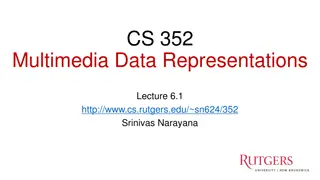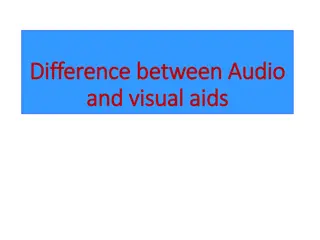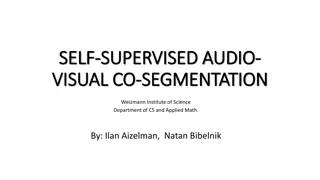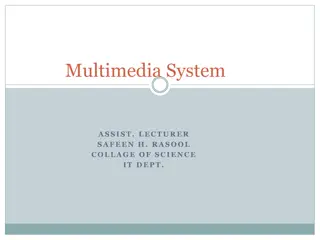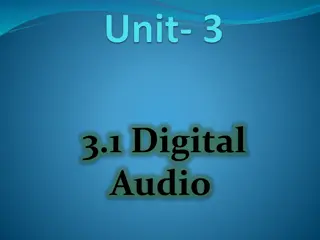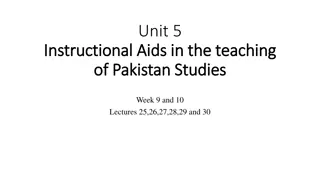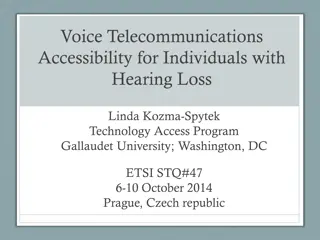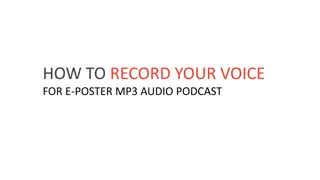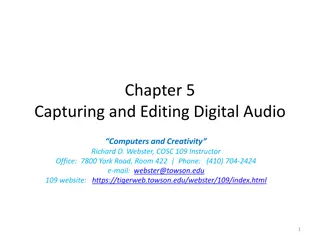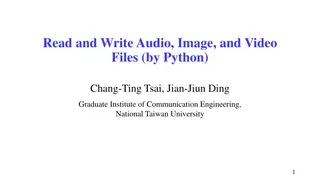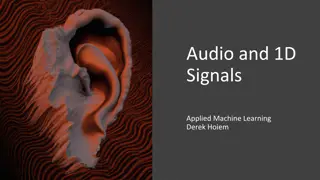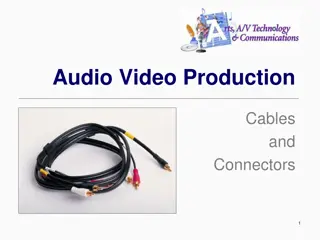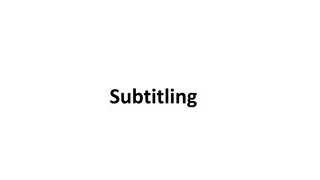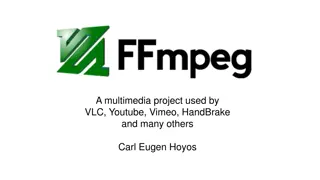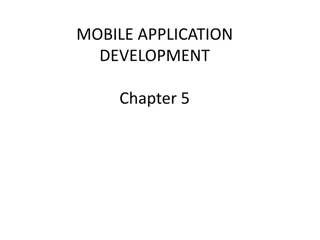Understanding Audio-COT in Medical Training
The Audio-COT is a valuable tool used in medical training to assess telephone consultation skills, complementing Workplace Based Assessment (WPBA). Supervisors review trainees' telephone consultations, provide feedback, and complete Audio-COT assessments, which count towards training requirements. Trainees select consultations reflecting a range of patient contexts, focusing on both face-to-face and telephone consultations. The assessment is part of professional development and not a pass/fail exercise, contributing to a comprehensive assessment of practice. Different clinical environments and consultation types are encouraged for assessment.
Download Presentation

Please find below an Image/Link to download the presentation.
The content on the website is provided AS IS for your information and personal use only. It may not be sold, licensed, or shared on other websites without obtaining consent from the author. Download presentation by click this link. If you encounter any issues during the download, it is possible that the publisher has removed the file from their server.
E N D
Presentation Transcript
Audio-COT Dr Chris Webb December 2020
What is the Audio-COT? The Audio-COT provides an additional tool to enable an assessment of telephone consultation skills, which complements the existing components of the Workplace Based Assessment (WPBA) The Audio-COT uses the same methodology and process of completing the assessment as the COT, but is used in a different setting The Audio-COT counts towards the total number of COTs needed in each training year
How the Audio-COT works? The supervisor reviews a number of your telephone consultations during the trainee s rotations in primary care, either via direct observation of a telephone consultation or via an audio recording The supervisor discusses the case with the trainee and gives feedback An Audio-COT assessment is then completed as evidence and documented in the Portfolio
Selecting consultations The trainee can be observed directly (using a dual headset, for example) or via a recording of the discussion (both patient and doctor) Complex consultations are likely to generate more evidence. The telephone consultation used for an Audio-COT should typically last between 10-15 minutes. The consultations should be drawn from the trainee s entire period of GP training, reflecting a range of patient contexts It is recommended that Audio-COTs are completed during the ST3 year of GP training. During primary care placements in ST1 and/or ST2 face to face consultations should be assessed following. However due to the increase in telephone consulting this may not be possible and the COT requirement for that placement can include the assessment of telephone consulting. In ST3 it would be expected for trainees to demonstrate their competence in consulting both in face to face consultations and on the telephone. There is no set number for how many of each are needed
Telephone consultations are undertaken in both the Unscheduled care / OOH setting as well as in the GP setting and the trainee is encouraged to undertake assessments in both clinical environments. Telephone consultations can either take the form a telephone triage call or a full telephone consultation. For this reason, not all areas of assessment may be covered in all telephone calls. Supervisors are encouraged to mark not observed for those descriptors that are not assessed It is natural for the trainee to select telephone consultations in which they feel they have performed well; the ability to discriminate between good and poor consultations indicates professional development. However, they should be reminded that the Audio-COT is not a pass/fail exercise. The assessment is part of a wider picture of their overall practice and presenting recordings that they feel perhaps did not go as well as they had hoped may result in greater learning WPBA and RCA are independent components of the MRCGP Tripos and therefore evidence submitted for one assessment cannot also be used for the other. All recordings submitted for the RCA should not be utilised for evidence for WPBA. Similarly, a consultation that has previously been assessed e.g. as an Audio-COT may not be submitted for the RCA as it has already been used as evidence for WPBA
Patient consent The patient must give consent to the telephone consultation either being listened to by a second doctor or being recorded, in accordance with the guidelines for consenting patients
Collecting evidence from the consultation The supervisor reviews the consultation with the trainee, relating their observations to the WPBA Capability framework and Audio- COT performance criteria The supervisor then makes an overall judgement and provide structured feedback, with recommendations for further development The trainee should be encouraged to reflect on the telephone consultation through a separate learning log entry
Capabilities The Audio-COT has been mapped to the RCGP Capability statements, which in turn will link to work place based assessment evidence in the Educational Supervisor Review
Trainee rating and overall assessment Trainees are rated for each area within the Audio-COT as not observed , needing further development , competent or excellent The supervisor is rating the trainee against detailed performance criteria Competent refers to the standard that would be expected of a GP trainee on completion of their training A global judgement is made at the end of the assessment tool regarding the safety of the telephone call
Introduces self and establishes identity of caller(s), ensuring confidentiality and consent PC1 The doctor is heard clearly to state their name, professional role and where they are calling from (GP surgery/out of hours (OOH) setting). The doctor is also heard to establish the identity of the caller, and if not the patient, obtains full relationship and name of caller. The PC encourages the doctor to make every effort to speak directly to the patient, using a high level of tact and negotiation skills. When clinically appropriate, the doctor should consider speaking briefly to a child or a patient with communication difficulties The doctor overtly obtains consent to the telephone call being listened to by a Supervisor. If the doctor has initiated the call, s/he should check with the caller that it is convenient to speak
Establishes rapport PC2 Rapport-building is an integral part of the communication process. The doctor creates a comfortable state where both parties converse freely and comfortably. An introductory verbal handshake is offered. The doctor is observed listening well, recognising non-verbal cues, responding with soft ums , ahs as they speak, using words the caller uses. The doctor is approachable and makes the caller feel supported, safe, and provides a reassuring approach, which gives the caller confidence in the care being delivered. Displaying confidence in the clinical ability can be harder over the phone. This PC encourages the doctor to develop good rapport with patient to facilitate effective communication
Identifies reason(s) for telephone call and excludes need for emergency response in a timely manner (when appropriate), demonstrating safe and effective prioritisation skills PC3 The doctor is able succinctly to ascertain at the start of the consultation the reason for the call, allowing a timely and appropriate history to be taken. The doctor is able quickly to recognise and exclude/confirm the manifestations of serious disease, demonstrating an appropriate knowledge of acute life-threatening conditions, e.g. chest pain, bleeding, altered consciousness This PC expects the doctor to respond appropriately and demonstrate an awareness of the need for an emergency response, by requesting in a focused and systematic way any relevant information to exclude medical, surgical and psychiatric emergencies. The PC incorporates the doctor showing s/he is able to act on information in an appropriate and timely manner, which includes indications that an emergency response may be required The doctor demonstrates a high level of prioritisation skills ensuring patient safety whilst maintaining efficiency. The doctor is able to prioritise the order of a telephone call, if appropriate, and the order in which problems are discussed on the telephone
Encourages the patients contribution using appropriate use of open and closed questions, demonstrating active listening and responds to auditory cues PC4 The doctor uses an appropriate amount of open questions and implies active listening by using reflection and facilitation. The doctor rarely interrupts the patient/caller and, if doing so, demonstrates clear advantages to their approach. The doctor effectively switches to closed questions during the telephone consultation if this is the most efficient method of obtaining the information, for example to determine whether or not a patient with headaches might have a serious illness such as raised intracranial pressure. The doctor does not pursue minor details or inappropriately explore rare diagnoses The doctor must choose the appropriate questioning technique to obtain sufficient information about symptoms and details of medical history, which in turn is part of defining the clinical problem(s). Appropriate questioning technique will allow a history in the degree of detail which is compatible with safety, but which takes account of the epidemiological realities of general practice The doctor is seen to encourage the patient s contribution at appropriate points in the consultation. This PC is particularly looking for evidence of a doctor s active listening skills, the ability to use open questions, to avoid unnecessary interruptions, and the use of non-verbal skills in exploring and clarifying the patient s symptoms The doctor is seen to respond to signals (cues) that lead to a deeper understanding of the problem. This competence is to respond appropriately to important, significant (in terms of what emerges afterwards) cues. The use of the telephone loses the doctors ability to detect visual cues, therefore attention to auditory/non-verbal cues is imperative This PC incorporates showing empathy ; if an empathetic response is observed, consideration should be given to whether it represents a response to a cue (i.e. the cue may be explicit, but the emotional significance that is being responded to may be quite subtle) The doctor quickly accesses Language Line or an alternative local translation service for non- English speakers. If appropriate, s/he may consider the use of a relative/friend to interpret for non- English speakers
Places complaint in appropriate psycho-social contexts PC5 The doctor uses appropriate psychological and social information to place the complaint(s) in context This PC expects doctors to consider relevant psychological, social (including occupational) aspects of the problem. These may be known beforehand, offered spontaneously by the patient, or elicited. The competence requires the use of the information in exploring the problem, e.g. How does your backache affect your life as a builder? The doctor must utilise the psychosocial information gathered to help inform decisions and actions made throughout the telephone consultation. The doctor recognises the effect this may have on whether s/he decides to convert the telephone consultation to a home visit, bring the patient up to the surgery at an appropriate time interval, or manage purely on the telephone
Explores the patient's health understanding/beliefs including identifying and addressing patients ideas, concerns and expectations PC6 The doctor demonstrates an effective exploration of the patient s health understanding in the context of the problem discussed on the telephone This PC incorporates exploring the patient s ideas, concerns and expectations, in the context of the patient s current illness or problem e.g. callers concern regarding an elderly parent not coping This PC expects doctors to demonstrate the curiosity to find out what the patient really thinks - a cursory, What do you think? without any response to the answer will not do. But questions like What did you think was going on? , What would be your worst fear with these symptoms? , Were you concerned this was serious? , What were you hoping I would do for this condition? are much more likely to get a valuable response. This may include reflecting on PC5, such as You said earlier xxx, what did you mean by that? which may enable the patient to talk more easily about their concerns
Takes an appropriately thorough and focused history to allow a safe assessment (includes/excludes likely relevant significant condition) PC7 The doctor obtains sufficient information to include or exclude likely relevant significant conditions and understand the problem This PC expects doctors to ask questions around relevant hypotheses. It is important to remember the context of general practice, and especially that trainees are not (usually) specialist-generalists in any field The doctor makes use of the pre-existing medical notes on the system (if applicable) and takes enough history of presenting symptoms to be able to make a safe and accurate assessment of the patient, to enable a safe management decision. In the way the information is gathered, the doctor demonstrates an awareness of all the more serious causes of the presenting symptom(s) In the OOH setting or with a temporary patient registered at the surgery, the doctor compensates for the lack of pre-existing notes available where information about the patient on the computer system may be sparse. The doctor takes enough history of presenting symptoms (and current medications, allergies and any relevant social history or circumstances, etc.) to be able to make a safe and accurate assessment of the patient s problem to enable a safe management decision. The doctor appropriately manages the request of the patient/caller, e.g. prescribing appropriate amounts of medication, for example tramadol, on the telephone The doctor uses a robust and effective structure to demonstrate well-developed triage skills for assessing clinical presentations from the information given to him/her. S/he demonstrates when to ask for more information if not enough is provided, or as a result of the response to a cue, some additional information is elicited leading to a deeper understanding of the problem The doctor must assess whether it is appropriate to undertake a physical or mental examination on the telephone. Although the doctor is unable to see the patient on the telephone, at times it can be helpful to ask the patient to perform examinations - e.g. Does a rash go white when pressed? , Is the patient able to complete a full sentence in a breath/count to 10 in one breath? An appropriate mental examination may be checking if a patient is suicidal is the tone of voice, flow of conversation congruent to the history provided? An examination performed over the telephone could confirm or disprove hypotheses that could reasonably have been formed, OR is designed to address a patient s concern This PC covers medical safety; it addresses the focused enquiry that commonly occurs during the telephone consultation, not necessarily at a particular stage even during the explanation, or even as an afterthought
Makes an appropriate working diagnosis PC8 There should be evidence observed that the doctor makes and records a clinically appropriate diagnosis or hypothesis
Creates an appropriate, effective and mutually acceptable treatment (including medication guidance) and management outcome PC9 The doctor must give the patient the opportunity to be involved in significant management decisions. The PC recognises the doctor s ability to establish the patient s willingness to be involved (at least a third are unwilling), their ability to take decisions (some are not able), and the evidence-base on which any decisions are being made. The doctor does not necessarily need to take the patient right through to a decision. The PC incorporates the assessment of the doctor s ability to negotiate, if appropriate, with the patient/caller, if they have initially been opposed to the management decisions but then agree with the outcome. The doctor should ensure the patient is fully consulted and understands the management decision, and as a result a mutually acceptable management plan is agreed There must be evidence of an adequate explanation of the patient s problem, appropriate to the clinical context/caller. A short explanation may be enough but it must be relevant, understandable and appropriate. The PC encourages the doctor to incorporate some or all of the patient s health beliefs, i.e. referring back to patient-held ideas during the explanation of the problem/diagnosis. Techniques such as summarising to clarify the problems will be used by the doctor to ensure understanding This PC includes an expectation that the management plan (including any medication guidance) relates directly, and is appropriate to, the working diagnosis and must represent good current medical practice The management offered or agreed must be a safe plan even though it may not be what the doctor would do as first line. Investigations and referral should be reasonable. The prescribed medication (if any) should be safe and reasonable, even if not the doctor s preferred choice
Seeks to confirm patients understanding PC10 The doctor specifically seeks to confirm the patient s understanding of the diagnosis. S/he uses appropriate language to explain the problem or a diagnosis and seeks to confirm that the patient understands the diagnosis, e.g. Does that make sense, is there anything you want to ask me? or so what are you going to do? /look out for? etc This competence implies quite a discrete process: a digression after the explanation, to check how well it has been understood. A cursory, Is that OK? , is not enough. It must be an active seeking- out of the patient s understanding. Questions such as, Tell me what you understand by that , or What does the term angina mean to you? , and a dialogue between patient and doctor ensuring that the explanation is understood and accepted, are essential. This PC is more important in a telephone consultation than in a face-to-face consultation as visual cues of agreement are not available
Provides appropriate safety-netting and follow-up instructions PC11 The doctor provides clear and precise safety-netting and follow-up instructions appropriate to the outcome of the telephone consultation. S/he provides clear instruction on contacting the surgery/OOH service again or other organisations if symptoms worsen, if the condition changes or the patient requires further information. The doctor also communicates clear time frames for the level of care agreed The safety-net instructions given should include a full description of relevant symptoms which indicate a significant worsening of the patient s condition that may require earlier intervention, tailored to the needs of the patient/caller and safety/risk of the consultation (e.g. If your headache is not better in 2 hours, ring back and we will re- assess the situation or sooner if you develop xxxx symptoms ) The doctor checks that the patient/caller is happy with the outcome and able to comply with any advice given
Manages and communicates risk and uncertainty appropriately PC12 The doctor is able to tolerate uncertainty, including that experienced by the caller, where this is unavoidable. The doctor anticipates and uses strategies for managing uncertainty The doctor is able to communicate risk effectively to the caller and involves them in its management to an appropriate degree. The doctor uses strategies such as monitoring, outcomes assessment and feedback to minimise the adverse effects of risk
Appropriate consultation time to clinical context (effective use of time taking into account the needs of other patients), with effective use of available resources PC13 The doctor demonstrates an awareness of time-management by taking control of the call when appropriate and focusing the questions and responses accordingly, to ensure the outcome was reached in a timely and safe manner. This is particularly important in the OOH setting The PC encourages the doctor to use appropriate communication skills and awareness of time- management:- for example, by taking control of the call and focusing the patient at all times when inclined to ramble , or by allowing the patient time to respond when appearing reluctant to discuss sensitive issues or demonstrating mental health issues e.g. suicidal ideation This PC also relates to the doctor using resources effectively. The doctor demonstrates an awareness of other resources to which it may be appropriate to refer, thus utilising the time more effectively. The doctor may signpost the patient/caller to a wide range of resources, e.g. patient information leaflets online, a minor injuries unit, district nurse referral, routine GP review at a timely interval or voluntary care sector resources, e.g. the Samaritans N.B. in the UK there are large differences, due to local guidelines or resources, in the resources available and the availability of investigations in primary care, e.g. access to d-dimer blood test and ultrasound scans
Accurate, relevant and concise record keeping to ensure safe continuing care of patient PC14 The doctor provides a clear, concise, accurate and relevant contemporaneous record of the patient encounter that includes all salient points relating to the diagnosis and management of the situation. S/he allows others involved in the care of the patient to be fully informed of the encounter and avoids the use of repetition, unusual or unacceptable abbreviations or subjective language All relevant medical information is recorded including a working diagnosis and also relevant social information, information regarding the patient s specific ideas and concerns and any advice about follow- up arrangements


